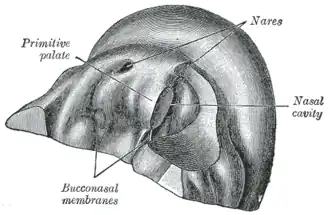Primary palate
| Primary palate | |
|---|---|
 Primitive palate of a human embryo of thirty-seven to thirty-eight days. | |
| Details | |
| Precursor | intermaxillary segment |
| Identifiers | |
| Latin | palatum primarium; processus palatinus medianus |
| TE | palate_by_E5.4.1.1.4.0.3 E5.4.1.1.4.0.3 |
| Anatomical terminology | |
The primary palate is an embryonic structure in the developing skull that, together with the more posterior secondary palate, separates the nasal from the oral cavity.[1] It is a derivative of the first pharyngeal arch.[2] Around the fifth week, the intermaxillary segment arises as a result of fusion of the two medial nasal processes and the frontonasal process within the embryo. The intermaxillary segment gives rise to the primary palate. The primary palate will form the premaxillary portion of the maxilla (anterior one-third of the final palate). This small portion is anterior to the incisive foramen and will contain the maxillary incisors.[3]
See also
- Hard palate – Comprised in part by the primary palate[3]
References
![]() This article incorporates text in the public domain from page 70 of the 20th edition of Gray's Anatomy (1918)
This article incorporates text in the public domain from page 70 of the 20th edition of Gray's Anatomy (1918)
- ^ Helwany, Muhammad; Rathee, Manu (5 June 2023). "Anatomy, Head and Neck, Palate". StatPearls. Treasure Island, Florida: StatPearls Publishing. PMID 32491749. National Library of Medicine Bookshelf ID NBK557817.
- ^ Shiba, Travis L.; Chhetri, Dinesh K. (2019). "Chapter 3 - Oropharynx". Dysphagia Evaluation and Management in Otolaryngology. Elsevier. pp. 13–21. doi:10.1016/B978-0-323-56930-9.00003-6. ISBN 978-0-323-56930-9.
- ^ a b Tepper, Oren M.; Warren, Stephen M. (2010). "Chapter 21 - Craniofacial Embryology". Plastic Surgery Secrets Plus (Second ed.). Mosby. pp. 139–145. doi:10.1016/B978-0-323-03470-8.00021-1. ISBN 978-0-323-03470-8.